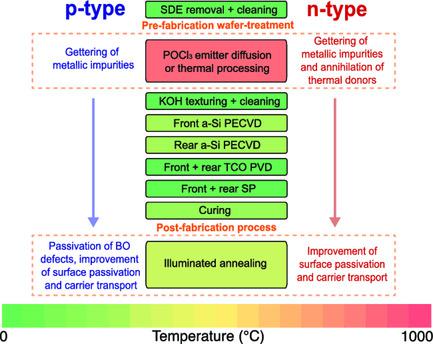当前位置:
X-MOL 学术
›
Phys. Status Solidi. Rapid Res. Lett.
›
论文详情
Our official English website, www.x-mol.net, welcomes your feedback! (Note: you will need to create a separate account there.)
Progress with Defect Engineering in Silicon Heterojunction Solar Cells
Physica Status Solidi-Rapid Research Letters ( IF 2.8 ) Pub Date : 2021-05-21 , DOI: 10.1002/pssr.202100170 Matthew Wright 1 , Bruno Vicari Stefani 1 , Anastasia Soeriyadi 1 , Rabin Basnet 2 , Chang Sun 2 , William Weigand 3 , Zhengshan Yu 3 , Zachary Holman 3 , Daniel Macdonald 2 , Brett Jason Hallam 1
Physica Status Solidi-Rapid Research Letters ( IF 2.8 ) Pub Date : 2021-05-21 , DOI: 10.1002/pssr.202100170 Matthew Wright 1 , Bruno Vicari Stefani 1 , Anastasia Soeriyadi 1 , Rabin Basnet 2 , Chang Sun 2 , William Weigand 3 , Zhengshan Yu 3 , Zachary Holman 3 , Daniel Macdonald 2 , Brett Jason Hallam 1
Affiliation

|
Due to the low temperature processing constraint in silicon heterojunction (SHJ) solar cells, no defect engineering to improve silicon wafer quality is typically incorporated during cell fabrication. This means that high-quality n-type Cz wafers are required to produce high-efficiency cells. Herein, recent demonstrations of incorporating defect engineering approaches, such as gettering and hydrogenation, into the SHJ process flow for both n-type and p-type wafers are surveyed. Defect engineering on wafers before cell fabrication can significantly improve the quality of low-lifetime p-type wafers, making them much more suitable for SHJ cells. Interestingly, these same approaches are also very effective in improving the cell performance in the n-type wafers that are conventionally used in industry. Post-cell illuminated annealing processes have been shown to eliminate boron–oxygen light-induced degradation (LID) in p-type wafers, leading to stable V
OC exceeding 735 mV. New results indicate that the hydrogen naturally incorporated during SHJ processing is sufficient to passivate these defects. Similar illuminated annealing processes also lead to substantial improvements in n-type SHJ cells. With these findings considered, it is demonstrated that a modified SHJ process flow, which includes defect engineering on a wafer level and post-cell hydrogen passivation, is beneficial for SHJ production, regardless of the wafer type.
中文翻译:

硅异质结太阳能电池缺陷工程研究进展
由于硅异质结 (SHJ) 太阳能电池的低温处理限制,在电池制造过程中通常不包含用于提高硅晶片质量的缺陷工程。这意味着生产高效电池需要高质量的 n 型 Cz 晶片。在此,调查了将缺陷工程方法(例如吸气和氢化)结合到 n 型和 p 型晶片的 SHJ 工艺流程中的最新演示。在电池制造之前对晶圆进行缺陷工程可以显着提高低寿命 p 型晶圆的质量,使其更适合 SHJ 电池。有趣的是,这些相同的方法在提高工业中常规使用的 n 型晶片中的电池性能方面也非常有效。V OC超过 735 mV。新结果表明,在 SHJ 加工过程中自然掺入的氢足以钝化这些缺陷。类似的照明退火工艺也导致 n 型 SHJ 电池的实质性改进。考虑到这些发现,证明了改进的 SHJ 工艺流程,包括晶圆级的缺陷工程和电池后氢钝化,无论晶圆类型如何,都有利于 SHJ 生产。
更新日期:2021-05-21
中文翻译:

硅异质结太阳能电池缺陷工程研究进展
由于硅异质结 (SHJ) 太阳能电池的低温处理限制,在电池制造过程中通常不包含用于提高硅晶片质量的缺陷工程。这意味着生产高效电池需要高质量的 n 型 Cz 晶片。在此,调查了将缺陷工程方法(例如吸气和氢化)结合到 n 型和 p 型晶片的 SHJ 工艺流程中的最新演示。在电池制造之前对晶圆进行缺陷工程可以显着提高低寿命 p 型晶圆的质量,使其更适合 SHJ 电池。有趣的是,这些相同的方法在提高工业中常规使用的 n 型晶片中的电池性能方面也非常有效。V OC超过 735 mV。新结果表明,在 SHJ 加工过程中自然掺入的氢足以钝化这些缺陷。类似的照明退火工艺也导致 n 型 SHJ 电池的实质性改进。考虑到这些发现,证明了改进的 SHJ 工艺流程,包括晶圆级的缺陷工程和电池后氢钝化,无论晶圆类型如何,都有利于 SHJ 生产。


























 京公网安备 11010802027423号
京公网安备 11010802027423号